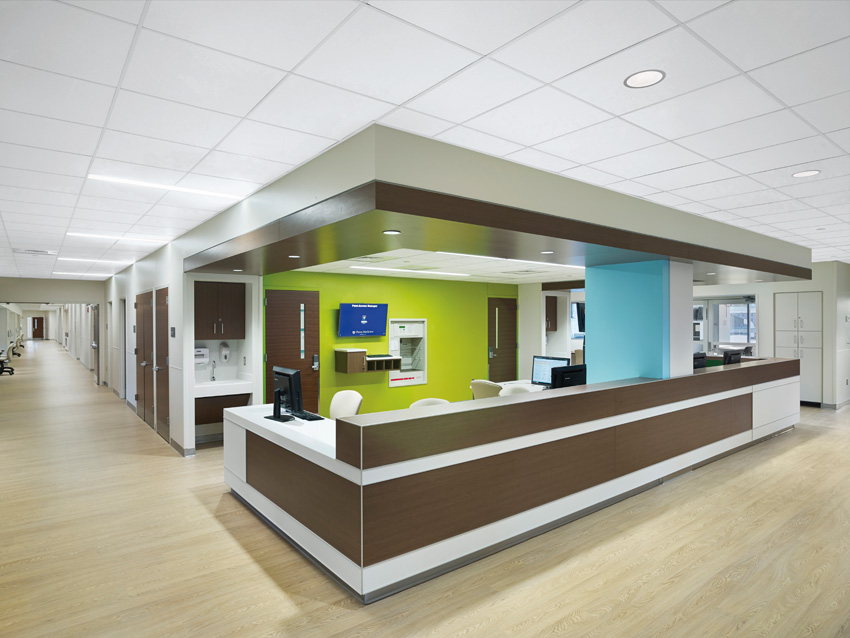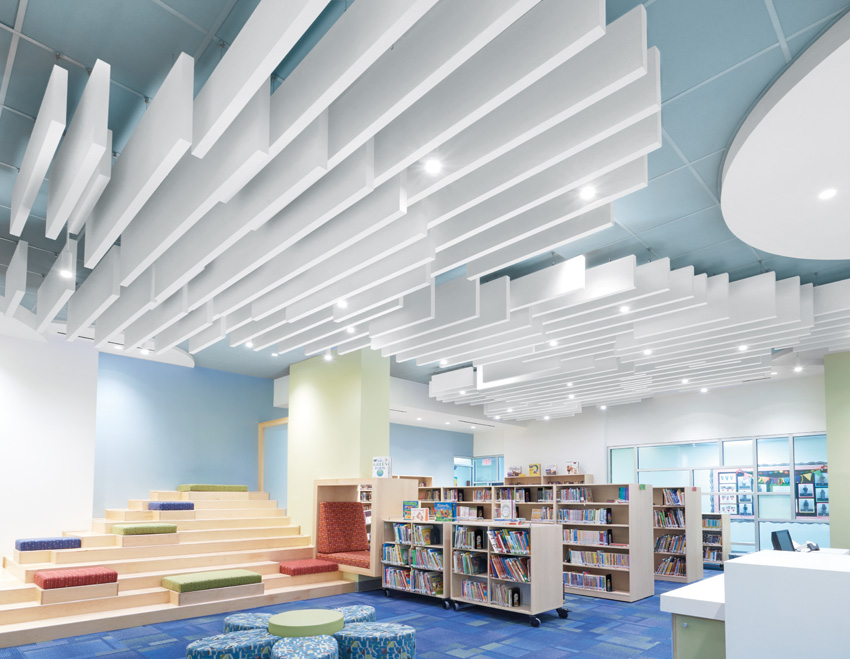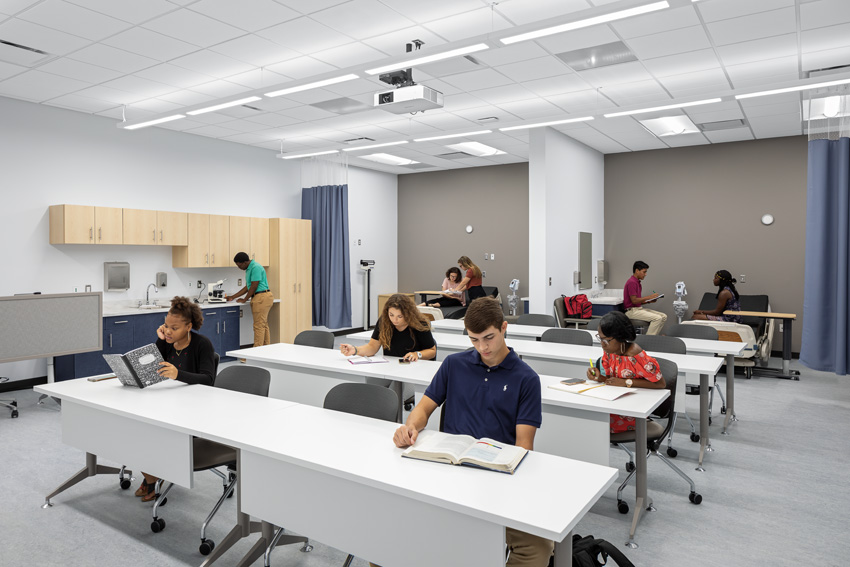Putting People First
Health-Care Facilities
As noted earlier, a known challenge with acoustics in health-care facilities stems from the many hard, sound-reflective surfaces, furniture, and equipment in various spaces. Reverberation time tends to be a problem, especially in older hospital designs, and that increases overall noise and reduces speech intelligibility. High-performance sound-absorbing ceiling panels with 0.70 NRC or higher can help control the reverberation in a space, reducing sound levels and improving speech intelligibility.
Ceiling panel installation will depend on the original site design as well as the ceiling height. With standard 10-foot ceilings, a suspended acoustical ceiling system can be the most cost-effective solution for reducing sound levels. However, for 12-foot ceilings and higher, additional sound-absorbing materials may be needed. Acoustical wall treatments can be used in this case to manage sound.
While addressing reverberation and speech intelligibility are important, so are measures that address HIPAA regulations requiring that health information remain private. This extends to information that is verbally communicated between medical staff, or between patients and medical practitioners. Following are some strategies for ensuring speech privacy and confidentiality.
- Ensure that examination rooms are acoustically balanced and optimized for a high privacy index.
- Install high-CAC ceiling panels to reduce sound transfer between adjacent spaces.
- Match wall STC values with ceiling CAC values to maximize confidentiality.

Registration areas and nurse stations both require acoustical treatment that ensures patient information remains private.
Balanced acoustical ceiling design is critical for enabling and ensuring speech privacy. The design will depend both on the materials and the placement within the space, and, as with offices, will depend on the differences between open and closed spaces. Open spaces such as reception areas and waiting rooms present challenges for maintaining speech privacy, and yet they are the very spaces where private information tends to be shared with hospital staff. Regardless of the situation, the ABCs of balanced acoustical design should provide speech privacy through absorbing, blocking, and covering sounds with strategically placed panels and background noise.
In closed spaces such as examination and treatment rooms, speech privacy is only an issue if conversations can be heard and understood outside of the room. If this is the case, balanced acoustical design can be used to isolate the sound with sound-blocking ceiling tiles and sound-absorbing wall panels. In such situations, speech privacy is critical in order to comply with HIPAA regulations.
Sound-blocking acoustical ceiling panels can help control sound transfer between spaces, enhancing speech privacy. For health-care facilities where privacy is critical, a high CAC is preferable.
Speech Privacy in Education Spaces

Quiet areas such as school libraries benefit from aesthetically designed, high-performance ceiling systems.
Every learning space should be designed with materials that accommodate the combination of human speech and multimedia communications, with the overall goal of allowing for clear verbal communication. To accomplish this, the space should reduce both sound and reverberation levels. The following are a few strategies to achieve speech privacy in education spaces.
- Strategically place classroom doors so that they are offset to minimize sound transfer.
- Specify and design with high-CAC ceiling panels in rooms adjacent to other spaces to block sound.
- Adhere to material presented by ANSI and the Acoustical Society of America (ASA) in its publication American National Standard Acoustical Performance Criteria, Design Requirements, and Guidelines.
Acoustical ceiling panels with high CAC values can be used to ensure that noises from adjacent spaces are blocked between rooms that share a common plenum. If the CAC value is not high enough, noises can reflect and bounce through the ceiling and into adjoining rooms.

Create better learning environments with ceiling panels that provide the ideal combination of sound absorption and sound blocking.
Advances in Total Acoustical Performance to Enhance Speech Privacy in Existing Spaces
With the growing need for speech privacy and confidentiality in all sectors, specifiers are often faced with the challenge of updating existing spaces. Rather than completely retrofit a space, high-performance ceiling panels with CAC 45+ can be installed to match partial-height walls that have equal STC values. Such panels can provide balanced acoustical performance between adjacent spaces where speech privacy was previously not possible. High-CAC ceiling panels have several benefits, including flexible design and efficient installation.
Panels that Enhance Speech Privacy
Ceiling panels that have CAC 45+, when combined with partial-height walls that have equal STC values, provide increased speech privacy in spaces where such privacy was previously unavailable. These panels can be installed for common wall constructions, such as partial-height, demountable, or full-height walls with unsealed penetrations, providing design flexibility and enhancing time and labor savings. High-CAC ceiling panels also contribute to several different standards, including the WELL Building Standard, FGI Guidelines for Healthcare, LEED v4, and HIPAA sound-isolation requirements for optimized sound isolation.
High-Performance Acoustical Ceiling Panels Can Benefit Building Occupants
A ceiling panel’s acoustical performance can impact building occupants in several ways. In spaces where the walls do not extend from the floor to the deck above, noise can travel through the ceiling plenum. In workplaces, for example, a conference room or private office that previously breached speech privacy requirements may be easily redesigned with high-performance panels that provide CAC 45+. By updating ceiling panels in the space with the proper acoustical performance needed, architects and designers can help employers better protect employee privacy.
In health-care facilities, a space designed using high-CAC ceiling panels can help ensure that patients in an exam room do not hear discussions between doctors and patients in adjacent exam rooms. This small change can help patients feel more confident about discussing their own medical concerns without the fear of being overheard.
Acoustical ceiling panels that protect speech privacy and contribute to balanced acoustical design in various education spaces can benefit both teachers and students by improving teaching and learning environments.
Aside from providing the necessary speech privacy and helping building occupants feel more secure that private information will not be overheard, spaces designed with high-CAC ceiling panels offer additional benefits. For example, ceiling panels that are manufactured with certified healthy materials add to healthy indoor air quality, all while making spaces lighter, brighter, and more welcoming. These attributes benefit occupants in any indoor environment, whether an office space, health-care facility, or school.
Conclusion
Balanced acoustical design for interior spaces has not always been a top priority, and even when it is considered in a project, it can be challenging to get right. Often problems with noise in a space stem from a variety of factors and can impact building occupants in those spaces—whether they are learning, working, or healing environments. In many cases, speech privacy and confidentiality can be compromised from a lack of proper acoustical treatment in a space. To solve this problem, specifiers should design with high-CAC ceiling panels to block sound and take speech privacy to the next level. Ceiling panels that have a CAC 45+ can be quickly and easily installed, transforming an existing space into a thoughtfully designed, acoustically balanced environment that enhances speech privacy and confidentiality in interior spaces such as offices, schools, and health-care facilities.
End Notes
1Jensen, KL; Arens, E; and Zagreus, L. “Acoustical quality in office workstations, as assessed by occupant surveys.” Proceedings: Indoor Air. January 2005. Web. 12 December 2019. escholarship.org/uc/item/0zm2z3jg.
2“Acoustics in Open Office Situations.” Ceilings & Interior Systems Construction Association. January 2016. Web. 12 December 2019. www.cisca.org/files/public/AcousticsinOpenOffice.pdf Accessed October 2019.
3Ryherd, EE; Waye, KP; and Ljungkvist, L. “Characterizing noise and perceived work environment in a neurological intensive care unit.” Journal of Acoustical Society of America. February 2008.
4Joseph, Anjali. “The Role of the Physical and Social Environment in Promoting Health, Safety, and Effectiveness in the Healthcare Workplace.” The Center for Health Design. November 2006. Web. 12 December 2019. www.healthdesign.org/sites/default/files/CHD_Issue_Paper3.pdf.
5“Guidelines for Addressing Acoustics in Educational Settings.” ASHA Working Group on Classroom Acoustics. American Speech-Language-Hearing Association. 2005. Web. 12 December 2019. www.asha.org/uploadedFiles/elearning/jss/6173/6173Article4.pdf Accessed October 2019.
 |
Armstrong World Industries is a leader in the design and manufacture of innovative commercial ceiling and wall systems. At home, at work, in health-care facilities, classrooms, stores, and restaurants, Armstrong Ceiling & Wall Solutions offer interior options that help
create healthy, sustainable spaces that protect people and cultivate well-being and comfort so they can be at their best.
Armstrong is committed to developing new and sustainable ceiling solutions, with design and performance possibilities that empower its customers to create beautiful, high-performance residential and commercial buildings. Armstrong continues to grow and prosper for the benefit of all its stakeholders. armstrongceilings.com/commercial |








